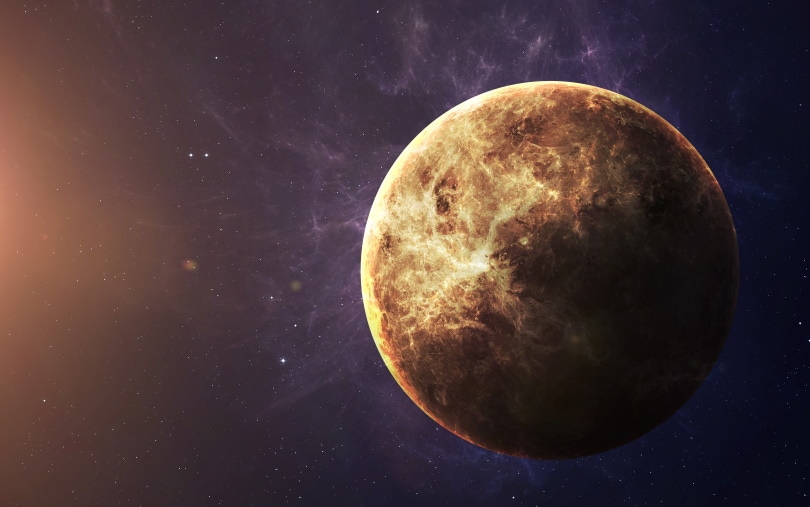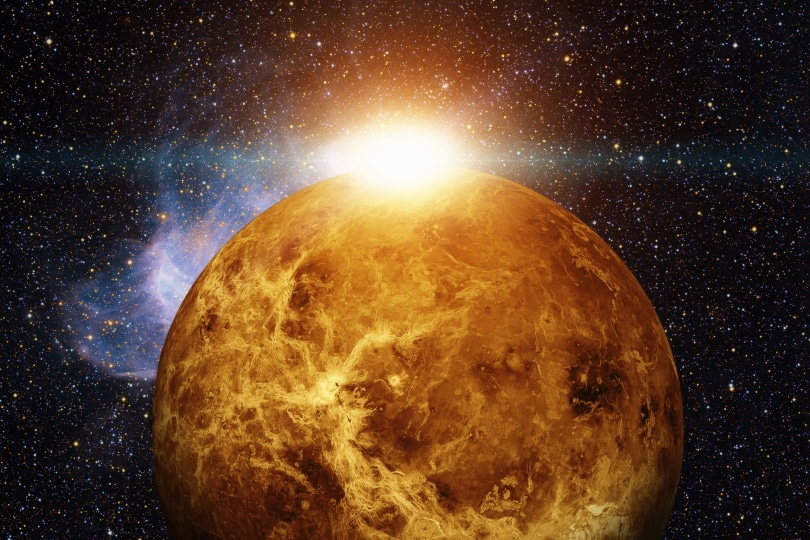What Color Is Venus?
Last Updated on

Venus intrigues us. After all, we are a mere 25,730,000 miles apart. Some have even referred to it as our twin planet. Earth and Venus are terrestrial bodies and both have a rocky surface. There’s also the fact that we can see Venus during the day, which makes it unique among the objects existing in our Solar System. From the yellow masses of sulfuric acid to the permanent cover of white clouds, there isn’t a direct answer on what color this planet is.
NASA‘s Mariner 2 did the first flyby of this planet in August 1962 at a distance of 21,660 miles away. But what images did the spacecraft share, and what have we learned since about the appearance and color of Venus?

The Atmosphere of Venus
Mariner 2 gathered some fascinating data in 1962. We learned that Venus has a thick cloud layer hovering above it about 50 miles above the surface that consists of carbon dioxide. It also has yellowish masses of sulfuric acid. Interestingly, the pressure is so high and the temperatures so hot that water can’t exist as we know it in liquid or vapor form. That means that the atmosphere obscures the surface color.

The Landscape of Venus
The United States and other countries have explored Venus extensively. In 1990, NASA’s Magellan gave us our first glimpse into what the surface looks like, including its topography and color. Its mass is about 80% of the Earth’s. It has a similar structure with an outer crust, mantle, and iron core. It’s covered with craters and valleys, many of which resemble topographical features on Earth.
It even has some active volcanoes. Scientists also theorize that the planet itself is geologically active and relatively young. The International Astronomical Union (IAU) has 2,036 identified elements sporting names, such as Xcanil Corona (the Aztec-Quiche maize goddess) and Stein (named after the American writer).
The Soviet Union’s Venera program created the first photographs of the planet. They confirmed tectonic activity on Venus. Its surface is rocky with scattered dust and debris, not unlike an uninhabited corner of the Earth. It’s worth noting that most of the Soviet probes succumbed quickly to the harsh atmosphere, some without returning any data.
NASA’s Parker Solar Probe was the latest spacecraft that traveled the closest to Venus at 515 miles away. It was able to measure the planet’s atmosphere, adding to our knowledge of its conditions. On February 9, 2022, the craft captured more surface images of Venus. Scientists observed the ground and rocks glowing because of the intense heat.
NASA also noted the presence of an airglow from oxygen atoms swirling around Venus in a ring-shaped pattern. Scientists remarked that we could sometimes see it on Earth. The agency has committed to three additional missions in the coming years. One goal is to learn more about the minerals present on Venus. This information could significantly add to our understanding and picture of the planet’s surface.


Final Thoughts
As close as Venus is to Earth, we have much to learn about our nearest planetary neighbor. We know that its atmosphere accounts for its yellowish color. The intense surface temperatures make it glow in the night—and sometimes day—sky. Future space missions will bring new information to light. Perhaps one day, its image will be as familiar to us as the Earth.
Featured Image Credit: Vadim Sadovski, Shutterstock
Table of Contents
About the Author Chris Dinesen Rogers
Chris has been writing since 2009 on a variety of topics. Her motto with all of her writing is “science-based writing nurtured by education and critical thinking.” Chris specializes in science topics and has a special love for health and environmental topics, and animals of all shapes and sizes.
Related Articles:
What Is the Best Binocular Magnification for Hunting? Optical Features Explained
15 Crucial Facts About Ultraviolet Rays & the Sun
What Constellation Is Spica In? The Interesting Answer!
10 Interesting Leo Constellation Facts, Myths, and FAQs
15 Interesting Pegasus Constellation Facts, Myths, and FAQs
6 Interesting Sagittarius Constellation Facts, Myths, and FAQs in 2024!
What Are Constellations? Where Did They Come From?
8 Interesting Libra Constellation Facts, Myths, and FAQs
